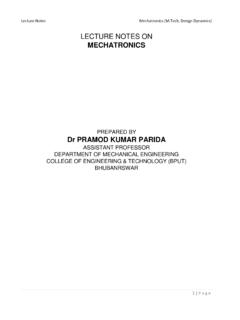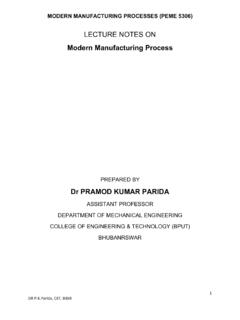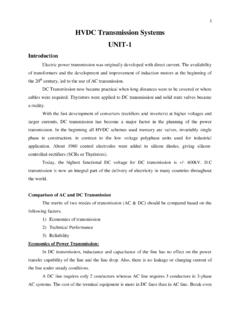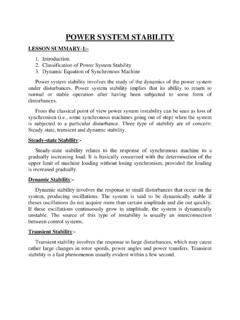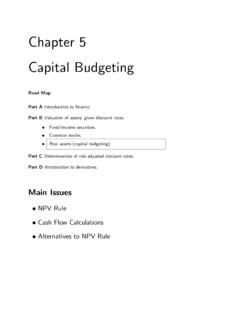Transcription of LECTURE NOTES ON - College of Engineering and …
1 LECTURE NOTES ON MOBILE COMPUTING SUBJECT CODE: PECS 5301 (3-0-0) PREPARED BY DR. PRASHANTA KUMAR PATRA College OF Engineering AND TECHNOLOGY, BHUBANESWAR PECS5301 MOBILE COMPUTING (3-0-0) Module - I 10 Hrs Introduction to Personal Communications Services (PCS) : PCS Architecture, mobility management, Networks signaling, Global System for Mobile Communication (GSM) System overview : GSM Architecture, Mobility management, Network signaling. General Packet Radio Services (GPRS): GPRS Architecture, GPRS Network Nodes, Mobile Data Communication; WLANs (Wireless LANs) IEEE standard, Mobile IP. Module - II 14 Hrs Wireless Application Protocol (WAP): The Mobile Internet standard, WAP Gateway and Protocols, wireless mark up Languages (WML), Wireless Local Loop (WLL) : Introduction to WLL Architecture, wireless Local Loop Technologies.
2 Third Generation (3G) Mobile Services: Introduction to International Mobile Telecommunications 2000 (IMT 2000) Vision, Wideband Code Division Multiple Access (W-CDMA), and CDMA 2000 Module - III 12 Hrs Global Mobile Satellite Systems ; case studies of the IRIDIUM, ICO and GLOBALSTAR systems. Wireless Enterprise Networks : Introduction to Virtual Networks, Blue tooth technology, Blue tooth Protocols. Server-side programming in Java, Pervasive web application architecture, Device independent example application. Text Books: 1. Mobile Communication: J. Schiller, Pearson Education 2. Mobile Computing: Patra, Dash, Scitech Publications.
3 3. Mobile Computing: Talukder, TMH, 2nd Edition. Reference Books: 1. Pervasive Computing: Burkhardt, Pearson Education. 2. Principles of Mobile Computing: Hansmann, Merk, Springer, 2nd Edition. 3. Wireless Communication & Networking: Garg, Elsevier 4. Third Generation Mobile Telecommunication Systems: P. Stavronlakis, Springer. 5. The Wireless Application Protocol: Sandeep Singhal, Pearson Education Module-I PCS (Personal Communication System) PCS stands for Personal Communication System. The objective of PCS is to enable communication with a person at any time, at any place & in any form. It also manages their individual call services according to their service by providing unlimited reachability & accessibility.
4 Sprint was the first company to set up a PCS network, which was a GSM-1900 network in the Baltimore-Washington metropolitan area in the USA. PCS promises to provide a wide range of locations and equipment-independent services to a large number of users. According to the definition given by the US Federal Communications Commission (FCC), PCS is the system by which every user can exchange information with everyone, at anytime, in any place, through any type of services, using a single personal telecommunication number (PTN). Key factors of PCS are: 1. Reachability with respect to Location (Home, office, in public, in transit) 1.
5 Accessibility with respect to Device (Cellular phone, wired phone, fax etc.) 2. Management of Service Architecture Architecture consists of two parts Radio Network PCS users carry mobile stations (MS) to communicate with a BS in a PCS n/w. MS is also referred to as handset or mobile phone. The radio coverage of a base station is called cell. In GSM n/w each cell is controlled by BSC which are connected to MS through BS. The BSCs are connected to MSC by landlines. Wireline Transport Network An MSC is a telephone exchange configured specially for mobile applications. It interfaces the MSC (via BS) with PSTN.
6 MSCs are also connected with mobility database to track the location of MS and roaming management. The databases are HLR & VLR. HLR contains the authentication information like IMSI (International Mobile Subscriber Identity), identification information like name, address of the subscriber, billing information like prepaid or postpaid, operator selection, denial of service to a subscriber etc. VLR gives information about the location area of the subscriber while on roaming and power off status of the handset. Fig PCS network Architecture Mobility Management Mobility mgmt function handles the function that arises due to mobility of the subscriber.
7 Main objective of MM is location tracking & call set up. There are two aspects of mobility in a PCS n/w. HANDOFF: When a mobile user is engaged in conversation, the MS is connected to BS via radio link. If the user moves to the coverage area of another BS, the radio link to old BS is disconnected and radio link to new BS is established to continue conversation. This process is called automatic link transfer or handoff. Depending on the mobility of MS, the handoff is divided into two categories: Inter-BS Handoff/ Inter Cell Handoff: Here MS usually moves from one BS to another BS under one MSC. Action taken for communication: 1. The MS momentarily suspends conversation & initiates the hand-off procedure by picking a channel in new BS.
8 Then is resumes the conversation in old BS. 2. When MSC receives that signal, he transfers the information to the new BS & sets up new conversation path to MS through that channel. 3. After MS has been transferred to new BS, it starts the conversation channel with new BS & then MSC disconnect the link with old BS. Fig Inter-BS link Transfer Inter-System Handoff/Inter-MSC Handoff MS moves from one BS to another connected to two different MSCs. MSC MSC MSC MSC Old BS New BS Old BS New BS Old BS New BS Old BS New BS (a) Step 1 (b) Step 2 (c) Step 3 (d) Step 4 Action taken for communication: 1.
9 MSC1 requests MSC2 to perform handoff measurement on the call in progress. 2. MSC2 then selects a BS by interrogating the signal quality and sends the information to MSC1. 3. Then MSC1 asks MSC2 to setup a voice channel. 4. Assuming that a voice channel is available in instructs MSC1 to start radio link transfer. 5. MSC1 sends the MS a handoff order. Now MS can access BS2 of informs MSC1 that handoff is then connects call path to MSC2. 6. In the intersystem handoff process, anchor MSC is always in call path before & after handoff. Fig Inter System Handoff Path Minimization- When MS moves to MSC3, MSC2 may be removed from the call path.
10 The link between MSC1 and MSC2 is disconnected and MS connects to MSC3 directly. This process is called path minimization. BS1 BS2 MSC1 MSC2 MS MSC2 MSC2 PSTN BS1 BS2 MSC1 MSC2 MS MSC2 MSC2 PSTN Fig Handoff Forward Fig Handoff Backward ROAMING: When a mobile user moves from one PCS system to another, then the system should be informed of the current location of the user. Otherwise it is impossible to deliver services. Two basic operations are performed under roaming management. 1. Registration (location update): Where MS informs the system its current location. 2. Location tracking: Process during which a system locates MS.

